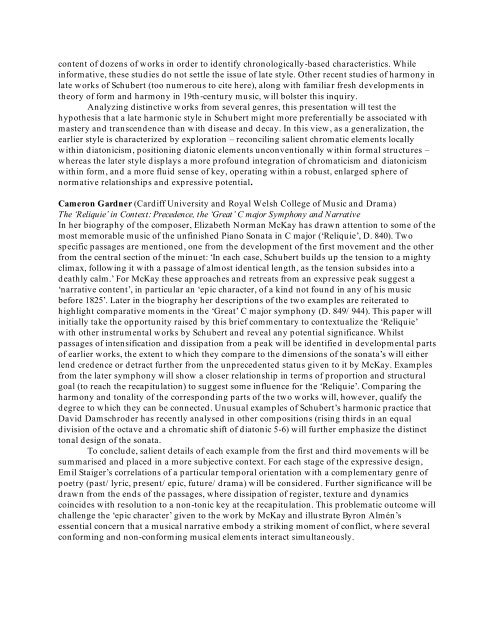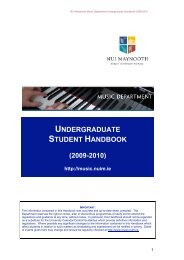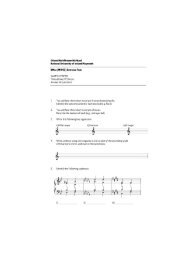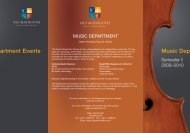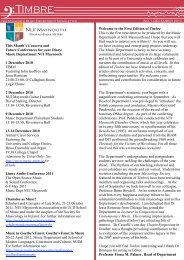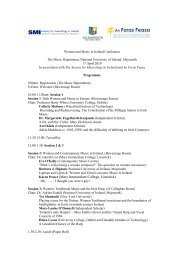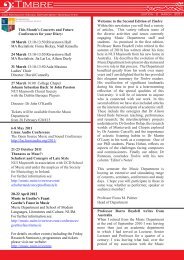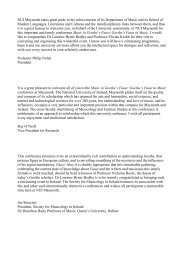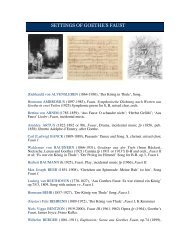Conference Booklet - Music - National University of Ireland, Maynooth
Conference Booklet - Music - National University of Ireland, Maynooth
Conference Booklet - Music - National University of Ireland, Maynooth
Create successful ePaper yourself
Turn your PDF publications into a flip-book with our unique Google optimized e-Paper software.
content <strong>of</strong> dozens <strong>of</strong> works in order to identify chronologically‐based characteristics. While<br />
informative, these studies do not settle the issue <strong>of</strong> late style. Other recent studies <strong>of</strong> harmony in<br />
late works <strong>of</strong> Schubert (too numerous to cite here), along with familiar fresh developments in<br />
theory <strong>of</strong> form and harmony in 19th‐century music, will bolster this inquiry.<br />
Analyzing distinctive works from several genres, this presentation will test the<br />
hypothesis that a late harmonic style in Schubert might more preferentially be associated with<br />
mastery and transcendence than with disease and decay. In this view, as a generalization, the<br />
earlier style is characterized by exploration – reconciling salient chromatic elements locally<br />
within diatonicism, positioning diatonic elements unconventionally within formal structures –<br />
whereas the later style displays a more pr<strong>of</strong>ound integration <strong>of</strong> chromaticism and diatonicism<br />
within form, and a more fluid sense <strong>of</strong> key, operating within a robust, enlarged sphere <strong>of</strong><br />
normative relationships and expressive potential.<br />
Cameron Gardner (Cardiff <strong>University</strong> and Royal Welsh College <strong>of</strong> <strong>Music</strong> and Drama)<br />
The ‘Reliquie’ in Context: Precedence, the ‘Great’ C major Symphony and Narrative<br />
In her biography <strong>of</strong> the composer, Elizabeth Norman McKay has drawn attention to some <strong>of</strong> the<br />
most memorable music <strong>of</strong> the unfinished Piano Sonata in C major (‗Reliquie‘, D. 840). Two<br />
specific passages are mentioned, one from the development <strong>of</strong> the first movement and the other<br />
from the central section <strong>of</strong> the minuet: ‗In each case, Schubert builds up the tension to a mighty<br />
climax, following it with a passage <strong>of</strong> almost identical length, as the tension subsides into a<br />
deathly calm.‘ For McKay these approaches and retreats from an expressive peak suggest a<br />
‗narrative content‘, in particular an ‗epic character, <strong>of</strong> a kind not found in any <strong>of</strong> his music<br />
before 1825‘. Later in the biography her descriptions <strong>of</strong> the two examples are reiterated to<br />
highlight comparative moments in the ‗Great‘ C major symphony (D. 849/ 944). This paper will<br />
initially take the opportunity raised by this brief commentary to contextualize the ‗Reliquie‘<br />
with other instrumental works by Schubert and reveal any potential significance. Whilst<br />
passages <strong>of</strong> intensification and dissipation from a peak will be identified in developmental parts<br />
<strong>of</strong> earlier works, the extent to which they compare to the dimensions <strong>of</strong> the sonata‘s will either<br />
lend credence or detract further from the unprecedented status given to it by McKay. Examples<br />
from the later symphony will show a closer relationship in terms <strong>of</strong> proportion and structural<br />
goal (to reach the recapitulation) to suggest some influence for the ‗Reliquie‘. Comparing the<br />
harmony and tonality <strong>of</strong> the corresponding parts <strong>of</strong> the two works will, however, qualify the<br />
degree to which they can be connected. Unusual examples <strong>of</strong> Schubert‘s harmonic practice that<br />
David Damschroder has recently analysed in other compositions (rising thirds in an equal<br />
division <strong>of</strong> the octave and a chromatic shift <strong>of</strong> diatonic 5-6) will further emphasize the distinct<br />
tonal design <strong>of</strong> the sonata.<br />
To conclude, salient details <strong>of</strong> each example from the first and third movements will be<br />
summarised and placed in a more subjective context. For each stage <strong>of</strong> the expressive design,<br />
Emil Staiger‘s correlations <strong>of</strong> a particular temporal orientation with a complementary genre <strong>of</strong><br />
poetry (past/ lyric, present/ epic, future/ drama) will be considered. Further significance will be<br />
drawn from the ends <strong>of</strong> the passages, where dissipation <strong>of</strong> register, texture and dynamics<br />
coincides with resolution to a non-tonic key at the recapitulation. This problematic outcome will<br />
challenge the ‗epic character‘ given to the work by McKay and illustrate Byron Almén‘s<br />
essential concern that a musical narrative embody a striking moment <strong>of</strong> conflict, where several<br />
conforming and non-conforming musical elements interact simultaneously.


